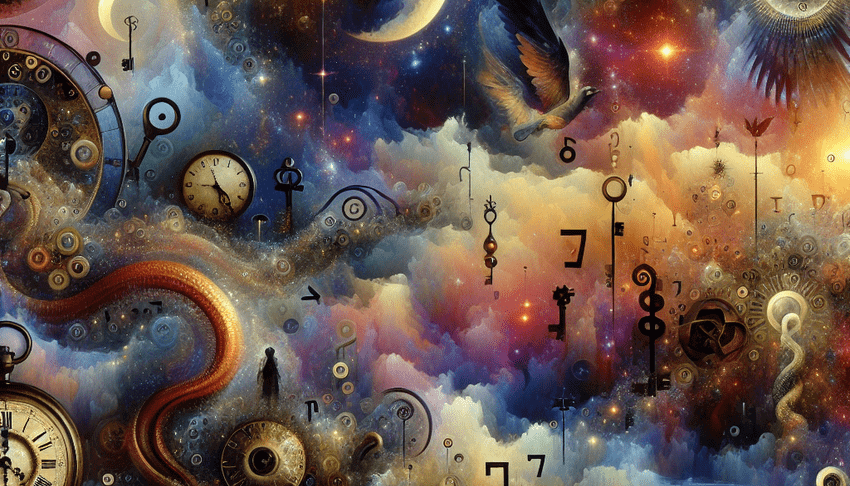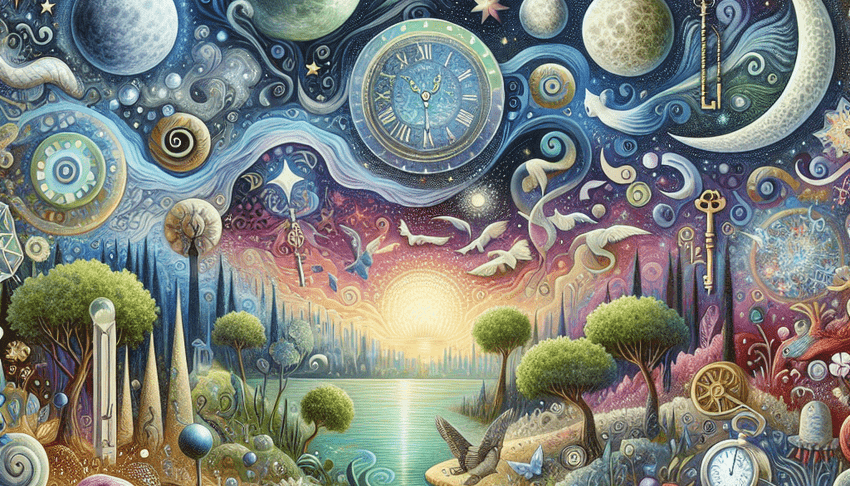Table of Contents
The Language of Dreams – Decoding Symbolism

Archetypes as Universal Symbols
Dream interpretation and symbolism have intrigued human consciousness for eons, straddling the line between mystical experience and psychological insight. At the heart of this exploration lies the work of Carl Jung, whose contributions to understanding the subconscious are unparalleled. Jung introduced the notion of Archetypes in dreams as primordial, universal patterns that reside in the collective unconscious. These archetypes in dreams are, in essence, the DNA of our psychological heritage.
Archetypes: The Language of the Unconscious
- Understanding Archetypes in dreams as “The Great Mother”
- Deciphering “The Shadow” in Nightly Visions
- The Embodiment of “The Hero” in Dream Narratives
One cannot overlook the significance of archetypes in the realm of dream symbolism. The “Great Mother” archetype often appears in dreams as a nurturing, life-giving figure or conversely, as a devouring entity. This dual nature represents the birthing of new ideas or the consumption and end of particular life phases.
“The Shadow” represents our darker, often ignored, aspects. Dreams that stir feelings of fear or confrontation with an unknown figure might signify an encounter with our shadow, urging us to integrate these neglected parts into our conscious selves for wholeness. Dream encounters with “The Shadow” encourage us to embrace all facets of our personality.
“The Hero” often emerges in our dreams during times of challenge and transformation. This archetype embodies courage, strength, and endurance, signifying our intrinsic potential for growth and triumph over adversity. Dreams cast us as “The Hero” in symbolic quests, battles, or journeys, serving as metaphors for the personal challenges we face in waking life.
Carl Jung’s work urges us to pay attention to these powerful symbols, for they speak a deep truth about our lives and experiences. In essence, dream interpretation can be a transformative endeavor, allowing us to tap into ancient wisdom that guides our personal development and growth.
To truly understand the depth of dreams, it’s essential to recognize the roles these archetypes play. They are not merely characters in the theater of the mind but catalysts for psychological integration and personal discovery. Each appearance of an archetype in our dreams is a lesson about ourselves and the collective experiences of humanity.
In conclusion, understanding the language of archetypes in dreams allows us to decipher the profound messages from our inner world, offering keys to unlocking growth, insight, and emotional intelligence. Dream symbolism, underlined by the timeless wisdom of Carl Jung, remains an invaluable tool in the quest for self-analysis and mental development.
Interaction Between Archetypes and the Individual Psyche
The intricate tapestry of our dreams is often woven with threads of mysterious symbols and motifs, which are not merely products of random neural firings but rather, speak a profound language of the subconscious. Among these symbols lie ‘Archetypes in dreams’, a concept popularized by Carl Jung that signifies universal patterns and images that are part of the collective unconscious. These archetypes are not static; they dynamically interact with an individual’s experiences, beliefs, and Emotional Intelligence.
Understanding the language of dream symbolism can be a gateway to self-awareness and personal growth. For instance, encountering a ‘wise old man’ or ‘great mother’ archetype in a dream may not just signify a need for guidance or nurturing in one’s life but reflect the dreamer’s own maturity and ability to offer wisdom or care to themselves or others. The dreamer’s personality traits determine the form and interaction with these archetypal figures, leading to a diverse range of possible interpretations.
In the dance of archetypes within the dreamscape, a powerful aspect is their role in Emotional Intelligence enhancement. When individuals recognize and interpret these symbolic representations, they develop a deeper understanding of their emotions and reactions. This acknowledgement can aid in the integration of these archetypal images into their conscious psyche, facilitating a more balanced self.
Empirical Evidence and Dream Interpretation
Archetypes in dreams have been studied within various cultural and individual contexts, demonstrating their pervasive influence across human experience. A dream about a raging river might universally symbolize emotional turmoil, but for an individual who loves white-water rafting, it could represent passion or challenge. It is this personalization of archetypal images that can lead to profound insights into one’s emotional landscape and pathways to personal development.
The practical implications of engaging with dream symbolism are evident. For example, a study might track dream journals and link archetypal occurrences to specific life events, showcasing how dreams reflect one’s inner world. By translating these symbols into conscious understanding, one can identify emotional patterns and triggers that are influential in day-to-day life, further honing Emotional Intelligence.
The Process of Archetypal Integration
It is not enough to simply decipher the symbols; the integration of these archetypes into the conscious mind is fundamental for personal transformation and the development of Emotional Intelligence. This process involves acknowledging the darker aspects, often represented by ‘the shadow’ archetype, and the more aspirational, such as ‘the hero’. Recognizing and harmonizing these aspects can lead to a more cohesive self-identity and the ability to navigate life’s complexities with greater emotional insight and stability.
In conclusion, the enigmatic imagery in our dreams carries immense potential for psychological and emotional insight. By delving into the symbiosis between archetypal representations and individual psyches, we equip ourselves with a tool for introspection and emotional advancement. The dynamic play of dream symbolism not only reflects our innermost thoughts and feelings but invites us to transform and develop throughout life’s journey.
The Interplay of Dreams and Emotion

Archetypes and Emotional Intelligence
Traversing the Landscapes of the Mind: Archetypes and Emotional Intelligence
Dreams are a universal human experience, a mysterious tableau where the conscious and subconscious mind meet. The work of Carl Jung, the influential psychiatrist and psychoanalyst, placed significant emphasis on the interpretation of dreams and the role of archetypes in dreams, laying the groundwork for a deeper understanding of our inner lives. Within these nocturnal narratives, dream symbolism serves as a powerful gateway to enhancing Emotional Intelligence (EI) – an individual’s ability to discern and respond to their own emotions and those of others.
Unraveling the Meaning: Dream Symbolism and Self-Awareness
At the heart of Emotional Intelligence lies self-awareness, the capacity to comprehend one’s own emotions. Dreams often host archetypal characters and symbols – universal patterns and images that Carl Jung proposed emerge from the collective unconscious. For instance, the ‘Great Mother’ archetype symbolizing creation or nurturing can appear in dreams during times of personal growth or when one is seeking comfort. By interpreting these dream symbols, individuals can gain insights into their emotional needs and latent desires, thereby bolstering the self-awareness component of EI.
- Example: A person dreaming consistently of water – often an archetype for the emotional realm – might be subconsciously exploring the depth of their feelings, leading to greater emotional clarity when awake.
- Case Study: Research has demonstrated that dream work can contribute to increased self-reflection, aiding clients in psychotherapy to uncover hidden emotional states and patterns.
Nurturing Empathy Through the Mirror of Dreams
Dream interpretation also plays a vital role in fostering empathy. Decoding the symbolic language of dreams can help individuals tap into emotions and experiences that are, on some level, shared by all of humanity. By engaging with archetypes in dreams, we begin to relate to the collective stories and emotions they represent, thus enhancing our ability to empathize with others.
- Example: Encountering the ‘Hero’ archetype in one’s dreams may ignite a connection with the universal journey of overcoming challenges, prompting a person to relate more deeply with others’ struggles.
- Research Insight: Studies on dream group therapy show participants often exhibit greater empathy, as they share and interpret their dreams together, finding common ground in their archetypal experiences.
Social Savvy: Dream Wisdom in Interpersonal Relationships
Lastly, dreams can be instrumental in navigating social complexities – another core aspect of Emotional Intelligence. By understanding the recurring themes and narratives that emerge within our dreams, we can better anticipate and navigate interpersonal dynamics.
- Real-World Scenario: A recurring dream of a ‘Shadow’ figure might reveal an aspect of the dreamer’s personality they struggle with, helping them to manage personal conflicts more effectively in social settings.
- Academic Perspective: A body of research suggests that individuals who engage in dream interpretation report improved problem-solving skills, particularly in social contexts, due to a heightened understanding of human behavior and motivations.
Dreams offer a reflective surface, a space where one can engage with archetypal imagery and unravel the complex tapestry of human emotion. Carl Jung asserted that by confronting these symbols, we could reach a more profound level of self-knowledge and understanding. In the domain of Emotional Intelligence, the integration of dream symbolism into our conscious awareness can significantly enhance our ability to perceive, assimilate, and manage the emotional landscapes within ourselves and in our relationships with others. As such, the archetypes in dreams are not merely relics of our collective past but dynamic instruments in the ongoing development of our Emotional Intelligence.
Transformative Power of Dream Analysis
Dreams have often been described as the mirror to our subconscious, a mystic realm where the mind unravels the deepest threads of our inner selves. The transformative power of dream analysis is an extraordinary journey of exploring these hidden landscapes and uncovering the messages that lie beneath our conscious awareness. Archetypes in dreams, as proposed by Carl Jung, serve as the universal symbols representing the collective unconscious of humanity. Their recognition and interpretation can catalyze profound psychological growth and facilitate personal development.
Archetypal Symbols: The Language of the Unconscious
Dreams are a canvas where the mind paints with symbols and narratives. Imagine dreaming of a serpent: to some, this may conjure thoughts of danger or deceit, but to others, it might symbolize transformation and healing, as with the shedding of its skin. Carl Jung identified these recurring motifs as archetypes – intrinsic elements of our collective psyche that transcend culture and time. When we delve into dream symbolism and identify these archetypes, we unlock aspects of our personality and life experiences that might otherwise remain obscured.
- Discovering the Self Through Dreams
- Navigating Life’s Crossroads
- Embracing Inner Change
Dream analysis can often serve as a guide at pivotal points in our lives. Whether facing a career change, personal loss, or seeking deeper self-knowledge, dreams can illuminate paths and provide clarity. When we decode the metaphors found in our nightly narratives, we can confront unresolved emotions and conflicts, paving the way for resolution and Emotional Intelligence development.
Cases of Transformation: Beyond the Dreaming Mind
Real-life examples abound where individuals have used dream interpretation to foster dramatic life changes. Take Sophie, a composer who dreamt of a forest ablaze, which led her to recognize a buried passion for environmental activism in her waking life. By confronting this latent aspect of herself, she could channel her creative abilities into a new purpose, fundamentally altering her life’s trajectory. Similarly, Alex, who repeatedly encountered a wise old man in his dreams, found the courage to mentor young people in his community, embracing a role he subconsciously aspired to.
Dreams, with their rich tapestry of archetypes and symbols, can profoundly influence our waking existence. The process of interpreting these nightly visions can propel us towards self-discovery, emotional healing, and psychological evolution. Moreover, by understanding the archetypes in dreams, we learn the language of the subconscious, a dialect that speaks to the commonalities of the human experience.
As we forge a path towards understanding our dreams, we must remember that this is not just about interpreting symbols—it is about integrating them. It’s the act of taking those revelations from our unconscious mind and applying them to our conscious life, enabling us to blossom into our fullest potential. This is the transformative power of dream analysis: it is an alchemy of the soul that turns the base metals of our nightly visions into the gold of deeper insight and personal growth.
Summary
Dream analysis, a subject permeating the bounds of mysticism and psychology, provides a lens through which we can glimpse the profound workings of the subconscious mind. Central to this fascinating discipline was the notable psychologist Carl Jung, who introduced the concept of archetypes as foundational elements residing in our collective unconscious—essentially, the DNA of our collective psychological makeup. By interpreting these archetypes in our dreams, we engage with a symbolic language intrinsically tied to our personal growth and self-understanding.
Archetypes: The Language of Dreams
Understanding the manifestation of archetypes in our dreams is a pivotal step toward self-discovery. These universal patterns appear in various forms, such as the nurturing or sometimes threatening figure of “The Great Mother,” signifying creation and transformation. “The Shadow” embodies our darker, unacknowledged self, surfacing in our dreams to provoke introspection and integration of all facets of our personality for greater wholeness. “The Hero,” representing courage and endurance, often guides us through dream sequences that mirror the personal challenges and transformations we encounter in waking life.
Unlocking the messages encrypted in our dreams through archetypal symbols allows us a deeper understanding of our own psyche and facilitates emotional intelligence. As such, dreams are not mere flights of fancy but poignant reflections of our internal state, serving as a tool for psychological insight and development.
Interpreting Dreams: A Personal Journey
The rich tapestry of the subconscious mind is woven with threads of personal memories and universal experiences. When we dream, these intermingle, creating a personalized narrative that reflects our individual emotional landscape. For example, water, a common dream symbol, could represent underlying emotional turmoil or tranquility depending on its state in the dream and the dreamer’s personal context. This individualized interpretation of archetypes allows us to unearth insights into our deepest emotions and subconscious thoughts.
Emotional Intelligence Through Dream Symbolism
Dream interpretation enhances Emotional Intelligence (EI) by fostering self-awareness. It serves as a practice ground for recognizing and managing emotions within ourselves and our interactions with others. Dreams can propel self-growth by encouraging the introspective analysis of archetypal imagery, resulting in greater empathy and social adeptness.
To truly grasp the transformative impact of dreams, one must embrace the notion of archetypes as not only subconscious messengers but also as guides toward a more integrated and emotionally intelligent self. Dreams, rich with archetypal significance, have the potential to unlock profound inner wisdom and emotional insights, ultimately contributing to our psychological evolution and personal development.
FAQ – The Role of Archetypes in Dream Symbolism
What is the role of archetypes in understanding the symbolism found in dreams based on Carl Jung’s theory?
In Carl Jung’s theory, archetypes are universal, primal symbols and images that reside in the collective unconscious and are central to understanding dream symbolism. They act as a bridge between the personal and collective aspects of the psyche, manifesting in dreams as recurring motifs or characters that carry specific meanings, such as the wise old man representing guidance or the shadow signifying repressed aspects of the self. By analyzing these archetypes in dreams, we can tap into the deeper layers of our psyche and gain insight into our innermost fears, desires, and motivations.
What is the connection between Carl Jung’s theory of archetypes and the interpretation of dream symbolism?
Carl Jung’s theory of archetypes posits that certain symbols and themes have universal meanings across cultures and are part of the collective unconscious. In dream interpretation, these archetypes manifest as recurring symbols or motifs that provide insight into an individual’s inner world and psychological development, enabling us to decipher the messages our dreams are conveying on a more profound, often existential level. For example, dreaming about a ‘wise old man’ might symbolize guidance or insight within oneself, tapping into the collective wisdom that Jung believed each person has access to.
What is the role of archetypes in understanding dream symbolism according to Carl Jung’s theory?
In Carl Jung’s theory, archetypes are fundamental elements of the human psyche that emerge in dreams through universal symbols and motifs. These archetypal images act as a bridge between our personal experiences and the collective unconscious, offering insights into our innermost fears, desires, and conflicts. By interpreting these symbols, we can better understand our own psychological makeup and the shared human experience.




